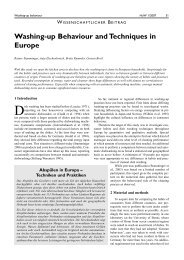Old Washing Machines Wash Less Efficiently and Consume More ...
Old Washing Machines Wash Less Efficiently and Consume More ...
Old Washing Machines Wash Less Efficiently and Consume More ...
Create successful ePaper yourself
Turn your PDF publications into a flip-book with our unique Google optimized e-Paper software.
Comparison Between <strong>Old</strong> <strong>and</strong> New <strong><strong>Wash</strong>ing</strong> <strong>Machines</strong> HuW 3/2005 127<br />
Table 1: Conversion factors to calculate the energy usage<br />
for washing programmes at different temperatures<br />
<strong><strong>Wash</strong>ing</strong> programme Conversion factor used<br />
temperature in °C based on 90 °C based on 60 °C<br />
90 1.000 1.600<br />
60 0.615 1.000<br />
40 0.335 0.540<br />
30 0.200 0.330<br />
Source: Own representation<br />
hing machines being 5 kg). Conversion factors deriving from<br />
thermodynamic calculations of an ‘average European washing<br />
machine’ (Kemna 2001) <strong>and</strong> used for official purposes<br />
(SAVE 2001) were used to calculate energy usage at different<br />
wash temperatures (Tab. 1), whereas water usage was<br />
assumed to be the same for all wash temperatures. Extrapolations<br />
for 1995 were possible both from earlier <strong>and</strong> from<br />
later years, averages of both were used to calculate what<br />
would be the most realistic usage value for 1995.<br />
In general, this results in a consistent picture (Tab. 2 <strong>and</strong><br />
Fig. 4) of the likely development of average usage values of<br />
washing machines in Germany since the beginning of the<br />
seventies. This picture is somehow different to what is<br />
published elsewhere (e. g. HEA 2002, p. 41), as here the<br />
focus is on the average of the market offer (as represented in<br />
the selection of models of Stiftung Warentest <strong>and</strong> CECED<br />
database) <strong>and</strong> not on the best available technology in this<br />
specific year. As millions of washing machines are sold per<br />
year, new technologies will not be introduced in all machines<br />
at a time but more in a continuous process. Therefore a<br />
smooth improvement of the average values per year is the<br />
more likely trend to be observed <strong>and</strong> a linear interpolation as<br />
shown in figure 3 does fit the data reasonably well.<br />
However, it must be stressed that our picture is based on<br />
a number of assumptions, that it required a number of corrections,<br />
<strong>and</strong> that individual machines may have diverged<br />
significantly from this picture. Never-<br />
theless, there have been significant<br />
improvements in the energy <strong>and</strong><br />
water usage of washing machines<br />
over the last three decades. For example,<br />
water usage was about four times<br />
as high in 1970 as in 2004, <strong>and</strong> more<br />
than two times as high only 15 years<br />
ago! On energy, the reductions over<br />
time for a defined washing temperature<br />
were also impressing, but not as<br />
high as on water. In recent years,<br />
however, this reduction in water usage<br />
has slowed down significantly,<br />
suggesting that it is becoming increasingly<br />
difficult to reduce water <strong>and</strong><br />
energy usage values further.<br />
W ISSENSCHAFTLICHER B EITRAG<br />
4 Performance of <strong>Old</strong> <strong><strong>Wash</strong>ing</strong> <strong>Machines</strong><br />
As a rule, the performance of a washing machine will<br />
stay the same – or even deteriorate – throughout its lifespan.<br />
Declines in performance due to material fatigue resulting<br />
from prolonged use can be detected in accelerated life tests,<br />
but at what levels of performance <strong>and</strong> water <strong>and</strong> energy usage<br />
do older appliances operate under current conditions?<br />
While households use appliances for ten or even many<br />
more years, other factors change more rapidly. For example,<br />
the textiles to be washed are changing constantly, not only<br />
due to fashion, but also as a result of new fibres or finishings<br />
being put on the market. Detergents are yet another field of<br />
constant change. <strong>Consume</strong>rs usually purchase detergents in<br />
quantities sufficient for a few weeks, but the next purchase<br />
may already have different ingredients <strong>and</strong> a different chemical<br />
formulation. Thus, innovations in detergents enter the<br />
market much more rapidly than innovations in the washing<br />
machines for which the detergents are bought. Therefore, the<br />
aim to study the behaviour of old washing machines under<br />
comparable conditions could only be done in using real old<br />
machines <strong>and</strong> testing them under today washing conditions,<br />
especially regarding the use of detergent.<br />
4.1 Methodology of Tests<br />
Tests were carried out on eight washing machines between<br />
9 <strong>and</strong> 29 years old <strong>and</strong> previously used in households<br />
in Bonn, Germany. For comparison, two new washing<br />
machines (manufactured in 2002 <strong>and</strong> 2004) were tested<br />
under the same conditions (Tab. 3). As the composition of the<br />
IEC reference detergent (IEC 60456 2003) is quite similar to<br />
that of modern compact detergents, only programmes<br />
without pre-wash were selected.<br />
To ensure comparability, all washing machines were loaded<br />
with the same amount of textiles. <strong>Wash</strong>loads of 4 kg<br />
were used in order to ensure that none of the machines under<br />
study would be operated under extreme loading conditions;<br />
overloading might have caused unrealistic problems in cleaning<br />
performance. <strong>More</strong>over, studies have found that, on<br />
Table 2: Calculated average energy (in kWh) <strong>and</strong> water usage (in l) for washing<br />
machines manufactured between 1970 <strong>and</strong> 2004 (for 5 kg cotton load)<br />
Temp. Year of manufacture<br />
1970 1975 1979 1980 1985 1990 1995 2000 2004<br />
30 °C 0.89 0.78 0.69 0,67 0.56 0.45 0.38 0.37 0.32<br />
40 °C 1.47 1.28 1.14 1.10 0.92 0.74 0.63 0.60 0.53<br />
60 °C 2.66 2.34 2.07 2.01 1.68 1.35 1.16 1.12 0.98<br />
90 °C 4.33 3.80 3.37 3.26 2.73 2.19 1.86 1.79 1.57<br />
water (l) 200 176 157 153 129 106 79 61 49<br />
Source: Own representation<br />
Bold figures are averages from data base – others are calculated as described





